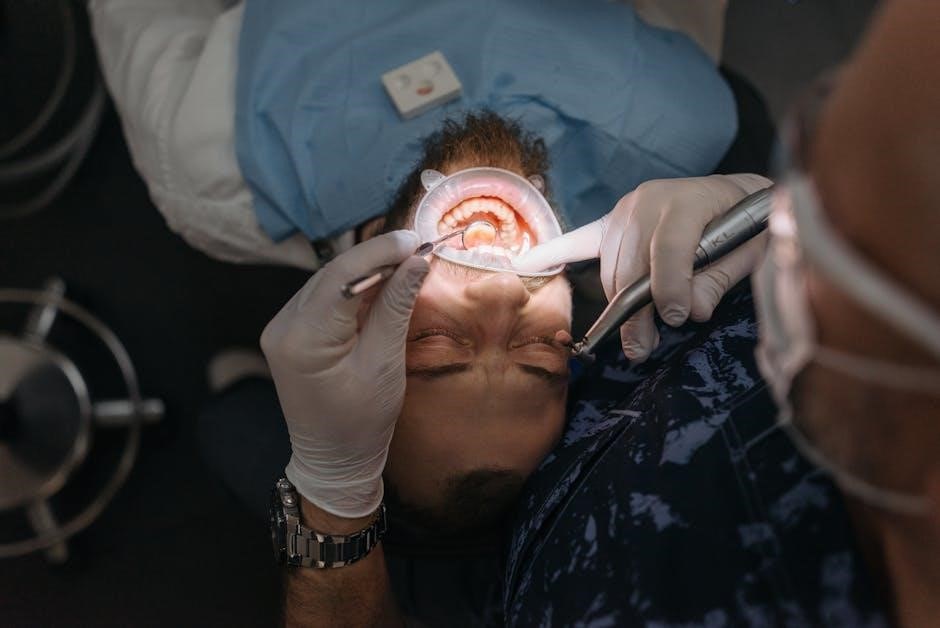A mouth guard is a protective device worn over teeth to prevent injuries and damage. Proper fitting and care ensure comfort and effectiveness during sports or nighttime use.
What is a Mouth Guard?
A mouth guard is a protective device worn over the teeth and gums to prevent injury or damage. Typically made of rubber, plastic, or silicone, it absorbs impact during sports or physical activities. It is also used to treat teeth grinding at night and can aid in snoring prevention. Available in various types, including boil-and-bite, custom-fit, and smart mouth guards, it offers tailored protection. Smart mouth guards even monitor concussion risks. Properly fitted, a mouth guard ensures comfort and effectiveness, making it essential for both athletes and individuals needing dental protection. Its versatility and durability make it a crucial tool for oral safety and health.
Importance of Using a Mouth Guard
A mouth guard is essential for protecting teeth, gums, and jaws from injuries during sports, physical activities, or teeth grinding at night. It acts as a barrier to absorb impact, reducing the risk of dental trauma and concussions. For athletes, especially in contact sports like boxing or hockey, it is crucial for preventing tooth loss and jaw fractures. Additionally, it helps alleviate symptoms of bruxism (teeth grinding) and can even aid in snoring prevention. Regular use ensures long-term oral health and safety, making it a vital accessory for both recreational and professional activities. Its importance extends beyond protection, offering peace of mind and preserving dental integrity for years to come.
Types of Mouth Guards
Mouth guards come in various types tailored to specific needs. Stock mouth guards are pre-molded and ready to use, offering basic protection but limited customization. Boil-and-bite models are softened in boiling water to create a personalized fit, balancing comfort and affordability. Custom-fitted mouth guards, made from dental impressions by a dentist, provide the highest level of protection and comfort, making them ideal for severe teeth grinding or high-impact sports. Additionally, specialized mouth guards address specific issues, such as snoring prevention or concussion monitoring in advanced models. Each type ensures optimal protection and comfort for its intended use, catering to diverse requirements and preferences.

Fitting and Molding Your Mouth Guard
Fitting involves softening the mouth guard in boiling water and shaping it to your teeth for a snug, protective fit, ensuring comfort and optimal protection during use.
Boiling Water Preparation

Begin by boiling water and immersing the mouth guard for 30 seconds to soften the material. Ensure the water reaches a temperature above 90°C for optimal pliability. After boiling, carefully remove the guard with a spoon to avoid burns. Quickly rinse it under cold water for a few seconds to cool it down slightly, making it easier to handle without causing discomfort. This step is crucial for achieving a moldable consistency that will conform to your teeth and gums properly during the fitting process. Proper preparation ensures a comfortable and secure fit.
Softening the Mouth Guard
Softening the mouth guard is essential for a proper fit. Start by immersing it in boiling water for 30 seconds to make the material pliable. Use a utensil like a fork to check if it’s soft enough. After boiling, rinse it briefly with cold water to cool it slightly, ensuring it’s warm but not scalding. This step ensures the guard can mold to your teeth without causing discomfort. Avoid overheating, as it may damage the material or cause burns. Once softened, the mouth guard is ready for molding, which will provide a snug and protective fit during use.
Initial Placement in the Mouth
After softening, carefully place the mouth guard over your upper teeth, aligning it with your dental arch. Ensure it covers all teeth evenly for optimal protection. Use a mirror to check proper alignment, making sure the guard sits comfortably without shifting. Gently bite down to secure it in place. Proper initial placement is crucial for achieving a snug fit. Once positioned correctly, proceed to shape it further by biting down firmly and using your fingers to press it against your teeth and gums. This step ensures the mouth guard adapts to your mouth’s contours for maximum comfort and protection during use.
Biting Down to Shape
After softening, place the mouth guard in your mouth and align it with your upper teeth. Close your mouth and bite down firmly, ensuring the guard molds to your teeth. Hold this position for a few seconds to allow the material to shape around your dental structure. Use your fingers to gently press the edges into your gums for a snug fit. Bite down hard enough to create an impression but avoid excessive force, which might deform the guard. Proper biting ensures the mouth guard conforms to your mouth’s contours, providing optimal protection and comfort during use. This step is crucial for achieving a custom-like fit.
Using Fingers to Press the Guard
After biting down to shape the mouth guard, use your fingers to gently press the edges into your gums and teeth. This step ensures a snug fit and proper adhesion. While the mouth guard is still warm and pliable, press firmly but carefully along the edges, focusing on areas where the guard may not fully conform to your mouth. This action helps create a tight seal and enhances protection. Use your thumbs to push the guard up and back against your molars, ensuring it molds evenly around your dental structure. This step is essential for achieving a secure and comfortable fit tailored to your mouth. Proper finger pressure ensures the guard stays in place during use. By pressing the edges, you maximize protection and comfort, making the mouth guard highly effective for its intended purpose. This step is crucial for both sports and nighttime use, providing a reliable barrier against impacts or grinding forces. Ensure the guard is evenly pressed to avoid unevenness or weak spots that could compromise its performance. This final adjustment guarantees the mouth guard functions optimally, offering superior protection and durability. Regularly checking the fit and re-shaping as needed ensures long-term effectiveness and comfort. Properly pressing the guard into place is a key part of the molding process, ensuring it remains secure and functional over time. By following this step carefully, users can enjoy a mouth guard that provides excellent protection and lasts for many uses. Regular maintenance and inspections are recommended to ensure the guard continues to fit well and perform as intended. This step is vital for achieving the best possible results from your mouth guard, whether for sports, grinding, or other uses. Properly pressing the edges ensures the guard stays in place and provides consistent protection. This step is a critical part of the fitting process and should not be overlooked for optimal performance. By taking the time to press the guard firmly into your gums and teeth, you ensure a secure fit that enhances both comfort and protection. This step is essential for achieving a professional-level fit without the need for custom molds, making it accessible to everyone. Properly pressing the guard into place is a simple yet crucial part of the process that significantly impacts the overall effectiveness of the mouth guard. By following these steps, users can enjoy a well-fitting, durable, and protective mouth guard tailored to their needs. This step is a key part of the process and should be done carefully to ensure the best possible results. Properly pressing the guard into place ensures a secure fit and optimal protection, making it an essential part of the fitting process. By taking the time to press the edges firmly, users can achieve a professional-quality fit that enhances both comfort and performance. This step is vital for making the most of your mouth guard and ensuring it provides the protection and comfort you need. Properly pressing the guard into place is a simple yet important part of the process that should not be rushed or overlooked. By following these instructions carefully, users can enjoy a mouth guard that fits securely and performs effectively, providing reliable protection for years to come. This step is a critical part of the process and should be done with attention to detail to ensure the best possible fit and performance. Properly pressing the guard into place is essential for achieving a secure and comfortable fit that enhances the overall effectiveness of the mouth guard. By taking the time to press the edges firmly, users can enjoy a mouth guard that provides excellent protection and lasts for many uses. This step is a key part of the process and should be done carefully to ensure the best possible results. Properly pressing the guard into place ensures a secure fit and optimal protection, making it an essential part of the fitting process. By following these steps, users can achieve a professional-level fit that enhances both comfort and performance. This step is vital for making the most of your mouth guard and ensuring it provides the protection and comfort you need. Properly pressing the guard into place is a simple yet important part of the process that should not be rushed or overlooked. By following these instructions carefully, users can enjoy a mouth guard that fits securely and performs effectively, providing reliable protection for years to come. This step is a critical part of the process and should be done with attention to detail to ensure the best possible fit and performance. Properly pressing the guard into place is essential for achieving a secure and comfortable fit that enhances the overall effectiveness of the mouth guard. By taking the time to press the edges firmly, users can enjoy a mouth guard that provides excellent protection and lasts for many uses. This step is a key part of the process and should be done carefully to ensure the best possible results. Properly pressing the guard into place ensures a secure fit and optimal protection, making it an essential part of the fitting process. By following these steps, users can achieve a professional-level fit that enhances both comfort and performance. This step is vital for making the most of your mouth guard and ensuring it provides the protection and comfort you need; Properly pressing the guard into place is a simple yet important part of the process that should not be rushed or overlooked. By following these instructions carefully, users can enjoy a mouth guard that fits securely and performs effectively, providing reliable protection for years to come. This step is a critical part of the process and should be done with attention to detail to ensure the best possible fit and performance. Properly pressing the guard into place is essential for achieving a secure and comfortable fit that enhances the overall effectiveness of the mouth guard. By taking the time to press the edges firmly, users can enjoy a mouth guard that provides excellent protection and lasts for many uses. This step is a key part of the process and should be done carefully to ensure the best possible results. Properly pressing the guard into place ensures a secure fit and optimal protection, making it an essential part of the fitting process. By following these steps, users can achieve a professional-level fit that enhances both comfort and performance. This step is vital for making the most of your mouth guard and ensuring it provides the protection and comfort you need. Properly pressing the guard into place is a simple yet important part of the process that should not be rushed or overlooked. By following these instructions carefully, users can enjoy a mouth guard that fits securely and performs effectively, providing reliable protection for years to come. This step is a critical part of the process and should be done with attention to detail to ensure the best possible fit and performance. Properly pressing the guard into place is essential for achieving a secure and comfortable fit that enhances the overall effectiveness of the mouth guard. By taking the time to press the edges firmly, users can enjoy a mouth guard that provides excellent protection and lasts for many uses. This step is a key part of the process and should be done carefully to ensure the best possible results. Properly pressing the guard into place ensures a secure fit and optimal protection, making it an essential part of the fitting process. By following these steps, users can achieve a professional-level fit that enhances both comfort and performance. This step is vital for making the most of your mouth guard and ensuring it provides the protection and comfort you need. Properly pressing the guard into place is a simple yet important part of the process that should not be rushed or overlooked. By following these instructions carefully, users can enjoy a mouth guard that fits securely and performs effectively, providing reliable protection for years to come. This step is a critical part of the process and should be done with attention to detail to ensure the best possible fit and performance. Properly pressing the guard into place is essential for achieving a secure and comfortable fit that enhances the overall effectiveness of the mouth guard. By taking the time to press the edges firmly, users can enjoy a mouth guard that provides excellent protection and lasts for many uses. This step is a key part of the process and should be done carefully to ensure the best possible results. Properly pressing the guard into place ensures a secure fit and optimal protection, making it an essential part of the fitting process. By following these steps, users can achieve a professional-level fit that enhances both comfort and performance. This step is vital for making the most of your mouth guard and ensuring it provides the protection and comfort you need. Properly pressing the guard into place is a simple yet important part of the process that should not be rushed or overlooked. By following these instructions carefully, users can enjoy a mouth guard that fits securely and performs effectively, providing reliable protection for years to come. This step is a critical part of the process and should be done with attention to detail to ensure the best possible fit and performance. Properly pressing the guard into place is essential for achieving a secure and comfortable fit that enhances the overall effectiveness of the mouth guard. By taking the time to press the edges firmly, users can enjoy a
Creating a Tight Fit
To create a tight fit, ensure the mouth guard is properly molded to your teeth and gums. After boiling and biting down, use your fingers to press the edges firmly into your gum line. Suck in strongly to create suction, ensuring the guard adheres closely to your teeth. Use your thumbs to push the guard up and back against your molars for a secure fit. This step ensures the mouth guard stays in place during use, providing maximum protection and comfort. A tight fit is essential for effectiveness, whether for sports, grinding, or other activities. Properly molding and pressing the guard guarantees a snug, reliable fit tailored to your mouth.

Care and Maintenance
Proper care and maintenance ensure longevity and hygiene. Clean your mouth guard with mild soap and rinse thoroughly. Use active oxygen solutions for effective cleaning without harsh chemicals.
Cleaning the Mouth Guard
Cleaning your mouth guard is essential for maintaining hygiene and preventing bacterial growth. Start by rinsing it under cold water to remove any debris. Use a mild soap or toothpaste with a soft-bristle toothbrush to gently scrub the surface. For deeper cleaning, soak the guard in a solution of equal parts water and active oxygen bleach for at least five minutes. Avoid using harsh chemicals or hot water, as they can damage the material. Regular cleaning ensures the mouth guard remains safe and effective for long-term use.
Storing the Mouth Guard
Proper storage is crucial for maintaining your mouth guard’s effectiveness. Use a protective case to shield it from harm and contaminants. Avoid extreme temperatures to prevent shape alteration or material degradation. After each use, rinse the mouth guard with cold water or mild soap to remove debris and bacteria. Store it in a cool, dry, ventilated place to prevent moisture buildup and mold. Keep the case clean and ensure it has proper airflow. Storing it out of reach of pets and children prevents accidental damage or loss. Avoid wrapping it in cloth to maintain its shape. Proper storage extends the lifespan and ensures hygiene and comfort for continued use.
Avoiding Damaging Materials
To maintain your mouth guard’s integrity, avoid exposure to harmful substances and conditions. Do not use harsh chemicals, such as bleach, as they can degrade the material. Avoid leaving it in direct sunlight or extreme temperatures, which can cause warping or softening. Never clean it with abrasive materials that may scratch the surface; Refrain from chewing on the mouth guard, as this can create cracks or weaken its structure. Additionally, avoid storing it in tight spaces or under heavy objects to prevent compression damage. Proper care ensures the mouth guard remains durable and effective for its intended use.

When to Use a Mouth Guard
Mouth guards are essential for sports, physical activities, and nighttime teeth grinding. They protect teeth, gums, and jaws from injury, ensuring safety and comfort during use.
Sports and Physical Activities
Mouth guards are crucial for athletes in sports and physical activities to protect teeth, gums, and jaws from injuries. They are essential for high-risk sports like rugby, hockey, and boxing, where impacts are common. Custom-fit mouth guards provide superior protection compared to generic ones. Smart mouth guards now incorporate concussion prevention technology, offering advanced safety. For hockey, mouth guards must cover both upper and lower teeth, while rugby players often opt for tailored designs. Boxing mouth guards are mandatory to safeguard against severe dental and jaw injuries. Regular use ensures long-lasting wear and reliability, making them indispensable for active individuals.
Teeth Grinding at Night
Mouth guards are essential for protecting teeth from grinding at night, a common issue that can lead to tooth wear and jaw pain. Custom-fit night guards, often recommended by dentists, provide a protective barrier between upper and lower teeth. They are molded to fit comfortably and prevent clenching. Thermoformed mouth guards, like those using boil-and-bite technology, are popular for their ease of use and effectiveness. Some devices, such as the DreamHero Mouth Guard, combine anti-snoring features with teeth grinding protection. Regular cleaning and proper storage ensure longevity. Night guards are a practical solution for maintaining oral health and preventing long-term dental damage caused by nighttime grinding habits.
Snoring Prevention

Mouth guards designed for snoring prevention, like the DreamHero Mouth Guard, work by repositioning the jaw and tongue to keep airways open during sleep. These devices are customizable using boil-and-bite technology for a secure fit. They promote restful sleep by reducing or eliminating snoring. Thermoformed materials ensure comfort and durability, while adjustable features cater to different mouth shapes. Regular cleaning and proper storage maintain hygiene and longevity. For best results, follow fitting instructions carefully to ensure effectiveness. Snoring prevention mouth guards are a practical solution for improving sleep quality and addressing mild sleep apnea symptoms, offering both comfort and reliability for nightly use.
Boxing and Contact Sports
Mouth guards are essential in boxing and contact sports to protect teeth, gums, and jaws from impact. They absorb shock, reducing the risk of concussions and dental injuries. A well-fitted mouth guard is crucial, as it stays in place during intense activities. Custom-fit options, like those made from dental impressions, offer superior protection and comfort. Thermoformed guards can also be molded at home using boiling water for a snug fit. Proper care, including regular cleaning and storage, ensures durability. Athletes should replace mouth guards after significant wear or if they no longer fit securely. Using a mouth guard is a critical safety measure in high-impact sports to safeguard oral health and overall well-being.

Safety and Precautions
Always ensure a proper fit to avoid choking or breathing difficulties. Avoid biting too hard, as it may cause damage. Clean regularly to prevent bacteria growth.
Understanding the Purpose of a Mouth Guard
A mouth guard is a protective oral device designed to shield teeth, gums, and jaws from injury or damage. Its primary purpose is to absorb impact during sports, physical activities, or accidental trauma. It also serves to prevent teeth grinding and clenching, which can lead to jaw pain or dental wear. For athletes, it reduces the risk of concussions and fractures, while for sleepers, it can minimize snoring by repositioning the jaw. Made from durable, comfortable materials, mouth guards are essential for both recreational and professional use, ensuring safety and comfort in various scenarios.
Ensuring Proper Fit
Proper fit is essential for a mouth guard to provide effective protection and comfort. Start by immersing the guard in boiling water to soften it, then carefully place it over your teeth. Bite down firmly to shape the guard around your teeth and gums. Use your fingers to press the edges into your gum line for a snug fit. Ensure the guard covers all upper teeth and aligns properly with your bite. Avoid over-tightening, as this can cause discomfort. Allow the guard to cool and harden in your mouth for a customized fit; A well-fitted mouth guard stays securely in place, offering optimal protection during sports or sleep.
Dangers of Improper Use
Improper use of a mouth guard can lead to reduced protection, discomfort, and potential harm. A poorly fitted guard may fail to protect teeth and gums during impact, increasing the risk of dental injuries. Over-tightening or incorrect molding can cause pain or difficulty breathing. Using a damaged or ill-fitting guard can lead to tooth movement or jaw strain. Additionally, improper care, such as exposure to extreme temperatures or harsh chemicals, can degrade the material, reducing its effectiveness; Always follow proper fitting and maintenance instructions to ensure safety and reliability. Neglecting these steps can result in ineffective protection and potential long-term dental issues.

Troubleshooting Common Issues
Common issues include improper fit, discomfort, and material degradation. Addressing these promptly ensures optimal performance and protection, preventing potential dental harm or injury during use.
Shrinking or Ill-Fitting Mouth Guard
If your mouth guard shrinks or doesn’t fit properly, it may cause discomfort or reduced protection. This often occurs from overheating during the molding process. To avoid this, ensure boiling water isn’t excessively hot and follow instructions precisely. If the guard becomes too small, it may be necessary to replace it. Proper sizing is crucial for both safety and comfort. Always test the fit after molding and consult a professional if issues persist. A well-fitting mouth guard is essential for effective protection during sports or sleep.
Difficulty in Molding
Difficulty in molding a mouth guard often arises from improper temperature control or insufficient biting force. Ensure the guard is soft but not overly hot, as excessive heat can cause shrinking. If the mouth guard becomes too hard, re-soak it in warm water for a few seconds. Properly align the guard over your teeth and bite down firmly, using your fingers to press the edges into your gums. If molding fails, start over with a new guard. Persistent issues may require a custom-fit solution from a dentist. Always follow the manufacturer’s instructions carefully to achieve the best results.
Discomfort or Pain
Discomfort or pain when using a mouth guard can stem from an improper fit, excessive hardness, or poor molding. If the guard feels too tight or causes jaw strain, it may not be molded correctly. Soak the guard in warm water to soften it further, then re-mold it, ensuring proper alignment with your teeth. If discomfort persists, consider using a mouth guard with adjustable thickness or consulting a dentist for a custom-fit solution. Avoid using a guard that causes chronic pain, as it may lead to long-term dental issues. Proper fit and material choice are crucial for comfort and effectiveness.

Advanced Features and Technologies
Smart mouth guards with concussion sensors, custom-fit options, and Gel Max technology enhance protection and comfort. These innovations ensure better performance, safety, and personalized fit for users.
Smart Mouth Guards for Concussion Prevention
Smart mouth guards are equipped with sensors to detect impacts and monitor for potential concussions. These devices provide real-time feedback, alerting athletes and coaches to head injuries during sports. By tracking the force of collisions, they help prevent long-term brain damage. Some models sync with apps, offering detailed reports on impact severity. This technology is particularly beneficial in high-contact sports like rugby and boxing. Smart mouth guards combine protection with innovation, ensuring both safety and performance. They are a vital tool in modern athletics, promoting player health and reducing the risk of concussions effectively.
Custom-Fit Mouth Guards
Custom-fit mouth guards are tailored to individual teeth and gum contours for optimal protection and comfort. They are created using dental impressions taken by a dentist, ensuring a precise fit. These guards are ideal for athletes or individuals with specific dental needs. The process involves molding the guard to match the unique shape of the mouth, providing superior protection compared to stock or boil-and-bite options. Custom-fit mouth guards are durable, reduce injury risk, and improve breathing during sports. They are also recommended for those with braces or dental work, offering personalized safety and comfort. This option is a top choice for long-term reliability and performance.
Gel Max Technology
Gel Max Technology enhances mouth guard performance with a soft, gel-like inner layer for superior comfort and shock absorption. This layer molds to teeth and gums, providing a snug fit while reducing impact force. Ideal for athletes, it offers durability and flexibility, maintaining shape even after repeated use. The gel layer also aids in dissipating energy from blows, reducing risk of mouth injuries. Cleaning is easy, and the material remains hygienic. Gel Max Technology balances protection and comfort, making it a preferred choice for sports and dental applications. Its innovative design ensures long-lasting performance and optimal safety for users. This technology is a significant advancement in mouth guard engineering.

Specific Use Cases
Mouth guards protect teeth during sports, grinding, and snoring. They are essential for boxing, rugby, hockey, and high-impact activities to absorb shock and prevent injuries effectively.
Using a Mouth Guard for Rugby
Rugby players often use mouth guards to protect their teeth and gums from impacts. These guards are essential for absorbing shock during tackles and falls. Custom-fit mouth guards are recommended for better protection and comfort. To mold a rugby mouth guard, submerge it in boiling water for 30 seconds, then bite down firmly to shape it around your teeth. Advanced features like Gel Max technology provide extra cushioning and durability. Proper fit is crucial to ensure the guard stays in place during intense play. Consulting a dentist for a custom-fit guard is advisable for optimal protection and performance on the field.
Mouth Guards for Hockey
Hockey players rely on mouth guards to protect their teeth and gums from high-impact collisions. Properly fitted guards are essential for absorbing shock and preventing injuries. Start by boiling the mouth guard in water to soften it, then bite down firmly to mold it to your teeth. Use your tongue to press the guard against the roof of your mouth and your fingers to ensure it fits snugly around your gums. Advanced materials like Gel Max technology offer superior cushioning and durability. A well-fitted mouth guard not only protects but also allows for clear communication during the game. Always follow fitting instructions carefully to ensure optimal protection and comfort.




Leave a Reply
You must be logged in to post a comment.